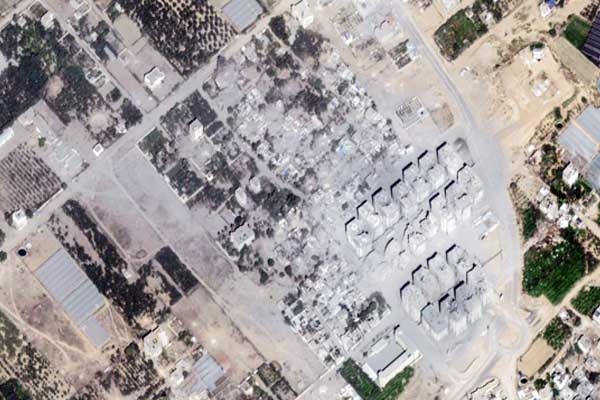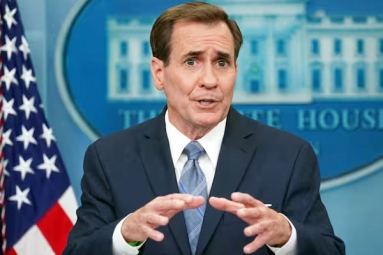
(Image source from: REUTERS)
On October 7, 2023, the militant group Hamas, which controlled Gaza, invaded Israel and launched Operation Al-Aqsa Flood, a deadly terrorist attack that killed more than 1,200 people nationwide. Israel was surprised. Hamas militants fired more than 5,000 rockets, paraglided in, tore down Gaza's walls and committed massacres. Israel responded with a ground and air attack on Gaza that has killed more than 40,000 people since last year. Israel has three main goals: to avenge the murder of its people, to eradicate Hamas from Gaza, and to safely return the hostages from the territory. The Gaza Strip was devastated and more than 66% of its buildings were destroyed, hundreds of thousands of people were displaced and thousands of people were killed in the bombings. Hamas's command and control structure has been disrupted, but several hostages have been returned and some who are believed to be alive remain in the Gaza Strip. The United Nations Satellite Center (UNOSAT) analyzed satellite images of 365 square kilometers of Earth. The report compares satellite images from September 2024 with photos taken before the invasion began. The report states: “UNOSAT identified 163,778 structures, of which 52,564 were destroyed, 18,913 were severely damaged and 56,710 were moderately damaged.”
EOS Landviewer's open-source satellite images show structural changes in the northern Gaza Strip, mainly near the Jabalia refugee camp, which was established in 1948 following the 1948 Arab-Israeli War. NDTV analyzed four images - three from the post-war period and one from 2022 - to understand changes to buildings and loss of farmland after the bombing. A photo taken by Sentinel 2 on September 26, 2024 shows a devastated area with little vegetation after the bombing. Comparing images of the same area with images taken on December 16, 2022, a year before the invasion, we see significant changes. Gray areas represent buildings and green areas represent agricultural areas. Gaza is one of the most densely populated areas in the world. More than 2.3 million people live in an area a quarter the size of Delhi. The area was evacuated on September 26 after several bombings.
Some families in this area migrated south to avoid death. Oxcarts, cars, trucks and other transportation were overloaded and there were mass evacuations and air and ground attacks. These images were compared with UNOSAT's agricultural area damage analysis to confirm significant changes. UNOSAT used the Normalized Difference Vegetation Index (NDVI), a widely used measure to quantify vegetation health and density using sensor data. In the north of the Gaza Strip there are 31.3 square kilometers of agricultural land, 79 percent of which have been destroyed, 24.6 square kilometers, and only 6.7 square kilometers remain. During conflict, natural vegetation is most at risk, leading to soil erosion and damage to agricultural land, affecting food production and causing other health impacts.
“This method assessed damage as a decrease in plant health and density in September 2024 compared to the previous seven seasons from 2017 to 2024. We can see a decrease in density,” the UN report said. Considering the impacts of activities such as demolition, heavy traffic, bombing, artillery fire and other conflict-related dynamics, the analysis includes an assessment of damage to orchards and other trees, crops and vegetables".
The analysis shows that the agricultural area in the Gaza Strip is estimated to be 150 square kilometers, which is about 41% of the total area of the Gaza Strip, where more than 42 million tons of rubble and flat buildings lie. Israel is being attacked from all sides. Although the frequency of attacks from Gaza has decreased significantly, the war has opened up several fronts for the country to contend with. In solidarity with Palestinians in the Gaza Strip, the Lebanese Shiite militia group Hezbollah has brutally attacked northern Israel, forcing more than 70,000 Israelis to flee their homes in search of safety.
Israel said the intensity of the conflict had shifted north to ensure the safe return of the people attacked, but there were pager and walkie-talkie explosions against Hezbollah across Lebanon, and he said the sectarian groups had claims they raised Israel and started a larger conflict. Behind the scenes of the explosion. As in Gaza, the conflict escalated into an air and artillery battle that killed thousands a week later, including the group's leader, Hassan Nasrallah, and his likely successor, Hashem Safi al-Din. Israel deposed the majority of Hezbollah leaders.
Meanwhile, Yemen's Houthi rebels, an Iran-backed group, have established a new front in Tel Aviv and have carried out several attacks since last year. Israel and Iran, West Asia's main enemies, have been in direct confrontation with missile and drone attacks since last year. Iran carried out missile and drone attacks against Israel in April after attacking the Israeli consulate in Damascus, Syria. The bullets were mainly aimed at civilian areas. The Israeli side also responded. Six months later, Iran fired more than 200 rockets at military and civilian areas, marking a paradigm shift in its approach to confronting Israel after Nasrallah's death. Israel's response to this attack is expected soon. Since last year, the United States and other regional powers have failed to broker a ceasefire as Israeli Prime Minister Benjamin Netanyahu continues his military targeting and attacks from Gaza unabated.



















